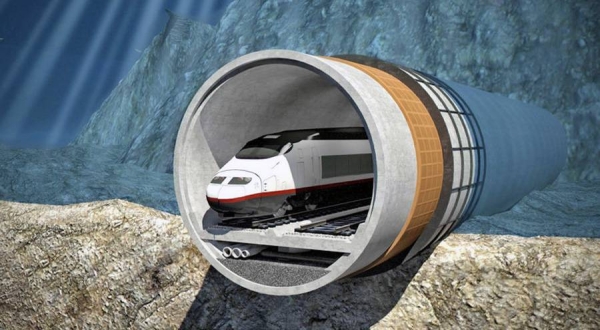A pioneering design to bore a train tunnel between Helsinki and Tallinn is gaining ground after Finland and Estonia signed a letter of intent. Finland and Estonia have signed a Memorandum of Understanding, taking plans for a long-discussed tunnel between the two nations a step closer to reality.
The privately funded project is headed up by entrepreneur Peter Vesterbacka and his FinEst Bay Area Development company — he made his fortune from the Angry Birds video game series (his nickname is Mighty Eagle).

A pioneering design to bore a train tunnel between Helsinki and Tallinn is gaining ground after Finland and Estonia signed a letter of intent. A rendering of the Helsinki-Tallinn tunnel.
The ambitious project would see two 103-kilometer-long high-speed rail passenger and freight tunnels dug 250 meters under the Gulf of Finland, between Helsinki in the north and Tallinn in the south, making the route far and away the longest undersea tunnel in the world.
The tunnels would be 17 meters in diameter, allowing each one to carry two train lines as well as pipes and conduits for other services if needed. In fact, the idea behind making them so wide is to future-proof them for advances in technology, such as new transport systems that can't be imagined today.
The granite bedrock spoil from the tunnels would be used to create two artificial islands 15km from each nation's coastline, providing ventilation, access and energy supplies to the tunnels below.
The larger one square kilometer island to the north would be transformed into an entertainment center with train station, shops, businesses and affordable housing.
The project is expected to cost €15-20 billion, and is controversially mainly funded by Chinese backers, leading to accusations of being far too accommodating of China’s Belt and Road Initiative.
Vesterbacka says the use of 16 plasma boring machines (12 to be used at any one time) will speed the project along, with completion of the tunnels anticipated as soon as December 2024.
The economic impact of such a venture is clear. Currently 10,000 Estonians commute every day by ferry to Helsinki for work — a journey that takes two hours in each direction. Conversely, Finnish tourists frequently visit Tallinn, drawn to its picturesque Old Town.
The proposed train journey would slash travel times to just 20 minutes, increasing the exchange of capital between the two cities as well as forging closer social and business ties.
An undersea rail tunnel linking Helsinki and Tallinn has been on the cards for almost a decade with multiple studies assessing its potential for socio-economic development for the two capital cities.
According to a pre-feasibility study financed by European Union EUBSR Seed Money Facility published in February 2015, the project is already a strong contender for success.
If constructed, the tunnel will be one of the longest underwater railway tunnels ever built and it will directly serve over four million people living in a 200km radius of both Helsinki and Tallinn. It will also carry about half of future cargo traffic in the area.
Promising improved accessibility and reduced commuting times via links to a wide-spanning network of transport modes, the tunnel is expected to rack up to 25,000 daily commuter trips in the first ten years after its opening. The revenue generated by passenger traffic would amount to €67billion by 2080.
Adding to its potential, the tunnel would also be connected with a planned €3.6billion Rail Baltica high-speed train line which is supposed to link Finland, the Baltic States and Poland and improve the connection between Central and Northern Europe.
While further assessments are in the pipeline, early evaluations hint at how the ambitious project could be built, financed and just how much it would change both passenger and cargo transportation in Northern Europe.
A European-standard track width would to be used in order to establish an easy link with Rail Baltica. To achieve the required speed, the rolling stock of tunnel transportation would be of speed shuttle type, with a basic unit comprised of two locomotives and eight carriages, plus other possible loading and unloading carriages.
The railway would be integrated into the local public transport systems of both countries, with intermodal links to Finland’s Central Railway station and Helsinki airport and Estonia’s traffic network at Ülemiste.
The Helsinki-Tallinn growth zone is part of the Trans-European transport network supported by the EU. Given that the railway aims to close an 80km gap traversable only by ferry, it falls within one of the key priority areas of the EU New Transportation Infrastructure Policy, which specifies: “Missing links, in particular at cross-border sections, are the major obstacle to the free movement of goods and passengers within and between the member states and with its neighbors.”
However, seeing that Finland is the second biggest trade partner for Estonia today, both countries are expected to reap the benefits of the wider consumer market and shared labor market that the tunnel would open up. (SG).
Tags
Kimataifa
